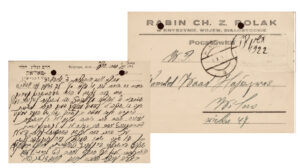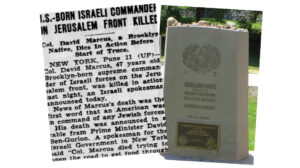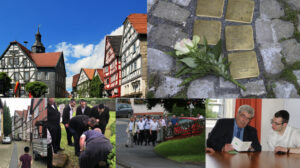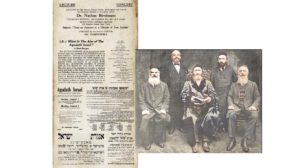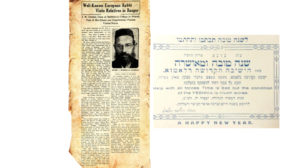When the Sky Fell

Three decades later, Lockerbie’s hidden angels relive the rescue of their brethren’s remains and bringing them to kever Yisrael
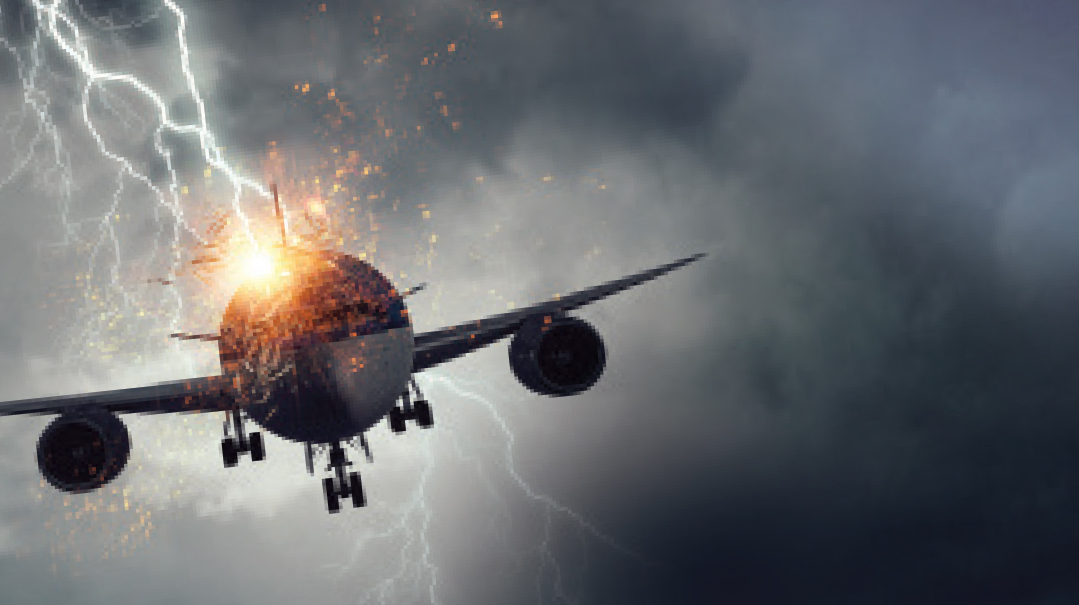
Photos: Family Archives
Air-traffic controller Alan Topp sat with his eyes fixed to the radar screen, watching the white marker indicating that Pan Am Flight 103, which had taken off from London’s Heathrow airport 27 minutes before, had crossed into Scottish airspace on its voyage across the Atlantic to New York. It was a pretty standard route, nothing too interesting that December night over three decades ago, but suddenly, Topp shot to full attention: The radar screen showed not just one blip where Flight 103 should have been, but four. Topp tried to contact the pilot of the aircraft, but there was no response. He buzzed the oceanic controllers responsible for the plane’s Atlantic crossing, but they too had lost contact with the plane. As his colleagues gathered around his screen, they would soon learn that those four blips represented the cockpit, the fuselage, an engine, and a wing hurtling to earth. A bomb had detonated from a Samsonite suitcase in the forward baggage hold, tearing the Boeing 747 apart at 31,000 feet in the air. Emergency procedures were never initiated, no oxygen masks had dropped down, and the cockpit levers were still set to cruise control.
Just before 6:30 p.m. on Wednesday, December 21, 1988, as the mammoth Boeing 747 rolled onto Heathrow’s Runway 27-Right, Captain Jim MacQuarrie, an experienced flyer with almost 11,000 flight hours under his belt, eased the four throttles forward and the 350-ton steel bird — nicknamed Clipper Maid of the Seas — flew into the winter night.
Once they were level at 31,000 feet, the pilots radioed in for clearance to cross the Atlantic and aim for New York. The flight attendants started to serve drinks.
The VIPs had settled into their business-class lounges and the economy passengers had arranged their limbs in the confined space. Thirty-five of them were students from Syracuse University — some of them Jewish — flying home after completing an exchange program. There was a party of US intelligence specialists on board, as well as a few well-known names: Bernt Carlsson, the UN commissioner of Namibia, was on his way to attend the signing of the New York Accords, slated to take place the following day. James Fuller, a US executive for Volkswagen, was on his way back from a meeting with other VW executives in Germany. Matthew Gannon, the CIA’s deputy station chief from Beirut, was safely ensconced in Business class seat 14J.
And 56-year-old Joseph Miller of Woodmere — senior partner in a Manhattan accounting firm, a beloved, bighearted communal activist who served as treasurer of the OU, on the board of directors of Yeshiva University’s Stern College for Women, and a staunch supporter of Yeshivat Shaalvim and other institutions — was on the flight too, returning from a one-day business trip to London together with his associate Jerry Weston.
The plane’s 243 passengers and 16 crew members were all blissfully unaware of the Samsonite suitcase in the forward hold, containing a Toshiba RT-SF16 radio cassette player fitted with a detonation device that would be activated automatically once the plane reached a certain altitude. (The terrorists assumed the bomb would be activated once the plane was over the Atlantic, in which case the aircraft, and all passengers, would have been plunged into the ocean depths.)
At 7:02 p.m., when the Clipper was at approximately 31,000 feet (about six miles into the atmosphere), an ear-splitting explosion punched a 50cm hole right through the left side of the fuselage. Within three seconds of the blast, the nose of the Clipper had sheered right off, a wing and engines had separated, and Pan Am flight 103 was plummeting out of the sky. For the next 46 seconds, as the passengers tumbled out of the plane from six miles up, many still strapped into their seats and instantly losing consciousness due to lack of oxygen, the dismembered aircraft twirled and plunged to the ground, landing in the small town of Lockerbie, Scotland. One section of the aircraft flattened several homes and created a 155-foot-long crater.
In all, 270 were killed — all 243 passengers and 16 crew members from the plane, and 11 civilians whose homes were incinerated on the spot, their bodies never retrieved.
Dad Was on the Flight
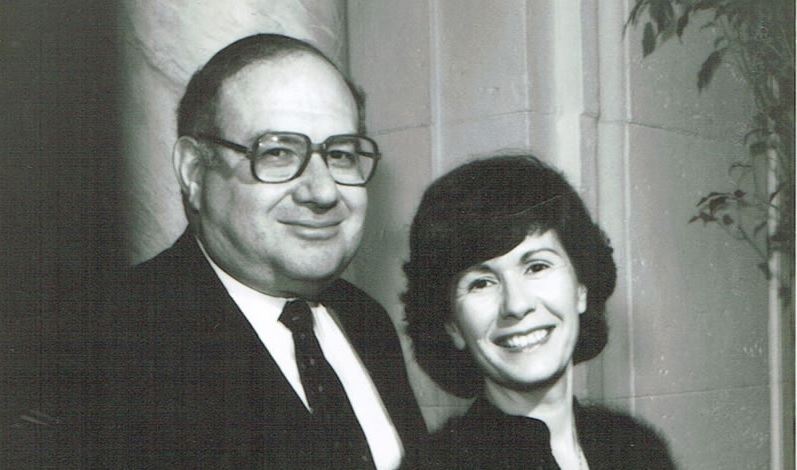
“Ma, what flight was Dad on?” Aliza was plugged into the news and had listened to the report about the Flight 103 crash with a growing sense of dread.
A quick phone call to Joe’s office confirmed it. Rhoda’s husband had been on that flight.
Mrs. Miller’s initial move was to contact their close friend Rabbi Shaya Lebor in Israel. He’d been the rabbi of the Young Israel of Woodmere from its beginnings in 1960 until 1981, when he made aliyah. It was the middle of the night, but Rabbi Lebor immediately contacted Rabbi Mallen Galinsky, coordinator of the American program at Yeshivat Shaalvim, of which Joe Miller had been a major supporter. Mrs. Sonia Galinsky still shudders when she recalls how she and her husband a”h headed out in the middle of the night to awaken the Millers’ son Gary and his new wife Karla, who were on their honeymoon in Jerusalem. Soon after, Rabbi Galinsky and Rabbi Lebor, both dear friends of Joe, were on a flight to Lockerbie, armed with simanim from Mrs. Miller that could help identify her husband.
Back home, Rhoda Miller then called Rabbi Heshy Billet, Rabbi Lebor’s successor at the Young Israel. It wasn’t long before he had a command post set up in the Miller living room. The huge question loomed: Where was Joe? Was it possible that he had survived the crash? And if the worst had happened, how quickly could they locate his remains and bring him to kever Yisrael? Anybody who knew anybody was contacted. The mission: Find Joe Miller.
And that’s how Mr. Joe Salomon, a Gateshead askan and brother of then-Gateshead mashgiach Rav Mattisyahu Salomon, got a phone call from Agudah in America. Gateshead was the closest Orthodox Jewish community to Lockerbie, Scotland. Could Salomon gather a few other fellows who could head over to Lockerbie to find out what had happened?
Lockerbie Below
It was a stormy night. Most Lockerbie residents were huddled indoors, busy with the upcoming holiday or watching television. Suddenly the lights went out, windows exploded, and trees and bushes burst into flame. Residents whose homes were still standing couldn’t believe the sight before their eyes: The world around them was suffused in orange light, and surrealistic balls of fire were hurtling from the sky.
And then there was silence.
When it seemed safe to emerge, the dazed residents exited their homes and began to take stock of what remained of their once-cozy town. The two hardest-hit streets were Rosebank Crescent and Sherwood Crescent. The rear fuselage of the aircraft, parts of the baggage hold, and three landing-gear units had made landfall on Rosebank, gutting houses and strewing yards with debris. Sherwood had become the unwitting target of the main engines and 200,000 pounds of jet fuel. A huge crater and raging inferno was all that remained of three of the homes on the block. The highly flammable gasoline had ignited on impact and started fires which rampaged through several of the adjacent homes. No identifiable remains survived the inferno.
Meanwhile, Joe Salomon had contacted Gateshead Chevra Kaddisha head Reb Shauli Spitzer, as well as his other brother, Reb Ezriel Salomon, a communal askan and school headmaster who was also a liaison officer to the Gateshead police. Spitzer and Ezriel Salomon then drafted a young, energetic bochur named Naftali “Totty” Lebrecht — whose wedding was just two weeks away — to rent a car so the three of them could drive up to the disaster site across the Scottish border.
“After confirming with Gateshead av beis din Rav Betzalel Rakow, who told us to get down there as quickly as possible, we downed a few cups of coffee and jumped into the Avis rental — which luckily came with a prized newfangled cell phone, a new invention at the time,” recalls Rabbi Lebrecht, who is today the administrator of Gateshead Yeshiva and director of Camp Agudah UK.
As the group sped toward Scotland, Shauli Spitzer ran through the halachos they would need to have at their fingertips. The trio had no whitewashed visions of what they were likely to see. A crash site as severe as Lockerbie meant top-priority body identification to avoid potential agunos and bring the Jewish passengers to kever Yisrael.
An hour and a half later, Lockerbie loomed. Five hours after the disaster, they found emergency personnel and police officers of the local Dumfries and Galloway police constabulary dashing around, trying to keep order and cordon off the stricken areas. Although it was near midnight, the main street was ablaze with light in response to the police order that the village stores open to provide for the emergency workers. A row of ambulances stretched bumper to bumper as far as the eye could see. The extent of the disaster was not yet known and they still nurtured hopes of finding survivors. Firefighters stood near the edge of the 150-foot crater, but one of the aircraft’s engines had flattened a municipal water pipe, cutting off their water supply. The fire service creatively pressed water-filled milk tankers into service which allowed them to begin to tackle the roaring blaze.
“When we arrived,” Rabbi Lebrecht says, “it was dark, there was a lot of confusion, and we didn’t really have a plan. But we found out where the police headquarters was, where the army set up headquarters for their search teams, where the American FBI and CIA had set up their teams, and most important, we found out where the mortuary was. They hadn’t found any bodies yet, as the search would only begin at daybreak.”
The team’s main goal at that point was to get a final passenger list from Pan Am, something the airline was extremely reluctant to do, as they were concerned about legal ramifications and being sued by relatives if they would comply. The group was soon in touch with Chief Rabbi Immanuel Jakobovits, who contacted the Home Office in an effort to secure further details.
“In the end we didn’t get it, because the lawyers for Pan Am put a stop on giving out information,” Rabbi Lebrecht says. “So we were advised instead that we should stay outside the mortuary, which would count as a shemirah in case any Jewish bodies would come in.”
The town hall was turned into a morgue, and the school building next door became disaster headquarters, with every few rooms allocated to different organizations. Throughout the night, various groups arrived and claimed rooms for offices: the FBI, the CIA (at that point no terrorist organization had taken credit for masterminding the blast), Tweed Valley Mountain Rescue team, the army, and the local police, fire, and ambulance squads. The Chevra Kaddisha and the Jewish Welfare Department were given an office as well. British Telecommunications (BT) spent the night laying miles and miles of cable, creating a gargantuan makeshift telephone exchange in the school’s parking lot.
While the Chevra Kaddisha was given a room, they weren’t given clearance for any kind of tactical operation. “But we were allowed to watch, which was good enough for us,” says Rabbi Lebrecht, “because at that point we weren’t searching for bodies, we were looking for information.”
And so, Totty Lebrecht’s windfall car phone became a vital tool of communication. They were fielding non-stop calls from family members who heard about the crash. Forty kosher meals had allegedly been ordered on that flight, but it turned out that there had been a flurry of Jewish defaulters by the time the gates closed. Dozens of families had no idea if their relatives were on the flight or not. It seemed that a group of chassidim from Boro Park and Monsey had switched flights at the last minute, and others wound up missing the flight due to heavy traffic.
“The night of the crash, there was a huge chasunah in Brooklyn,” says Rabbi Lebrecht. “The chassan was from a very well-connected family in London, and there were over 20 guests who were supposed to be on this flight — their plan was to fly out at six and with the five-hour time lag, they’d be in New York in time for the wedding. But in the end none of them got on the flight — either they switched at the last minute or came to the airport too late. But because we didn’t have the final list, we didn’t know who was on and who wasn’t.”
It was soon clear to the three men that the tragedy was too large for the Gateshead Chevra Kaddisha to handle alone, and so Manchester Chevra Kaddisha director Shlomo Adler and Manchester beis din administrator Yehuda Brodie were summoned. So was Rabbi Mordechai Bamberger of Glasgow. Over the next week, they would counsel bereaved families, help identify the dead, and expedite the Jewish burials.
No Lists
Shaken relatives began to fly in from across the globe. The tiny Jewish Welfare room was a welcome haven in a town bewildered by hordes of emergency workers and reams of red tape. The rescue workers, who had been fanning over miles of crash debris in the dark of night amid the harsh elements, decided it would be more productive to resume their search at first light the next morning.
At first, the locals hoped that the plane had been a military craft, and that the pilot had somehow safely bailed out. Hugh and Margaret Connell, sheep farmers with several farms in the surrounding areas, realized the reality was different when on a road near their now electricity-less farmhouse, Hugh’s flashlight fell on the coarse fabric of a bulging mailbag. Military planes didn’t carry mail. Could it have been a passenger plane? The couple forged forward in the freezing night to comb their land for wounded survivors.
They were several miles away from the crash site, but their painstaking search through the grassy fields was soon rewarded: they found the body of a 40ish-looking man, still strapped to seat 11B, with almost no outward marks of injury. The couple then kept watch over him until rescue workers arrived the next day.
When morning dawned, the dull daylight breaking through an unremitting cloud cover revealed the magnitude of the disaster. Farmers who had found some scattered airline seats and belongings by the light of their flashlights now saw their fields littered with the tragic fallout for dozens of kilometers around. Pieces of luggage, in-flight reading material, personal effects, passports, and food and clothing mingled with airplane fragments drenched in aviation fuel.
Helicopters were everywhere, sent by the American army, the British, and local police. The skies were swarming. From the outset, the Scottish police was treating the disaster as a terrorist crime scene and preserved anything that might be evidence. Anything recovered was meticulously catalogued. More than 4 million bits of plane wreckage and 10,000 other debris would eventually be retrieved in total.
The local ladies rose to deal with their own grief — 11 of their neighbors had been killed by the impact — by churning out tray after tray of baked goods for the workers to “keep the boys going.” They also decided to launder the victims’ clothes, a project which morphed into a year-long volunteer service, washing and ironing the recovered clothing of the deceased so that their families could claim these last mementos of their loved ones. This goodwill, however, proved to be one of the many challenges for the Chevra Kaddisha people, as bloody clothing can sometimes help with identification, and is supposed to be buried with the niftar. (In retrospect, it was also a mistake from an investigative angle to launder the clothing before the operation was finished, as those articles are considered forensic evidence.)
But that wasn’t the only battle they faced. Pan Am had an agreement with the Kenyon emergency services company, which contracted to take care of all the bodies — including the Jewish ones — and return them to the grieving families. Kenyon did agree that bodies identified as Jewish would not undergo autopsies, but they weren’t so fast about releasing the bodies to the Chevra Kaddisha.
“We wanted the bodies released as soon as possible, to bring them to kever Yisrael as soon as possible, but that wasn’t their first priority, and they were only prepared to communicate with immediate relatives,” says Rabbi Lebrecht. The crash happened over Scotland, which has very strict legislation in this regard; only next of kin are permitted to identify the corpses, although Rabbi Galinsky and London-born Rabbi Lebor were permitted to identify Joseph Miller, whose body was eventually found ten days later, on New Year’s Eve — and with nary a scratch.
That was the biggest miracle, he says. Although it took about two weeks to retrieve all the victims because of the vast distance of the fallout, all the Jewish bodies were retrieved whole and intact, and none of them broke up on impact to Earth.
“The Jews Are Doing Better”
Totty Lebrecht returned to Gateshead before Shabbos, as his aufruf would be the following week. He was replaced by Yosef Schleider, who would later become Rosh Kahal of Gateshead.
“We were stationed in the school which had become the headquarters for the disaster,” Reb Yosef recalls. “As body after body was brought into the school, we were able to calm the families of the Jewish victims with the latest updates. A dozen Jewish families — most of them not religious or unaffiliated — came. We heard from others who said, ‘the Jews are getting a lot better advice on how to deal with this tragedy than we are.’ That’s because our priorities were giving emotional support in how to deal with the deaths, and to get the bodies to kever Yisrael, which was a huge comfort even to the non-religious, while the other teams were busy bussing out families to see the crash site.”
Reb Yosef and the others stayed in Lockerbie until the last Jewish body was retrieved — that of Joe Miller, found after nearly two suspense-filled, pain-ridden weeks on the crown of a small hill near Lockerbie. The Chevra Kaddisha people on the site expedited bringing the niftar to London, from where he was transported to the United States, and from there to Eretz Yisrael, to the Eretz Hachaim cemetery outside Beit Shemesh. Shlomo Adler accompanied the meis to the US, where he handed Rhoda Miller another miraculous find: Joe’s suitcase, wallet, and his astonishingly intact tefillin.
Bodies Intact
For Jay Levinson, a counter-terrorism and security expert who in 1988 was head of the Disaster Victim Identification unit of the Israeli Police, Lockerbie began with a phone call from his supervisor. Until the year before, the department had been under the auspices of the IDF, and now the police who were in charge wanted information and procedures on how to handle and process a mass civilian disaster of that magnitude.
The Israeli police sent Levinson, who came to Israel in 1981 from Silver Spring, Maryland, on a technical, information-gathering mission — but his arrival in Lockerbie was nothing short of a gift to the onsite Jewish activists. As a foreign-security operator, Levinson was welcomed with deference by the local authorities and given the run of the town, including restricted areas and the morgue. As he attended all the police and search-team briefings, he was then able to convey valuable pieces of information to the Chevra Kaddisha team.
Each evening, he briefed the anxious British rabbanim about identification and kevurah updates, staying in constant contact with Dayan Aharon Dovid Dunner and Dayan Chanoch Ehrentreu. When the ordeal was over, he and the rest of the Jewish activists were gratified that Dayan Ehrentreu certified all of the identifications as meeting halachic standards. There would be no agunos.
Were the bodies all identifiable? “Absolutely,” says Levinson, noting how almost all the bodies fell down from the sky intact, but also explaining that for halachic identification purposes, a whole body isn’t necessarily needed. “What you need to see is an eiver shehaneshamah teluya bo, a vital organ that would indicate the person can’t be alive, since he couldn’t survive without it.”
Levinson, a professor of counter- terrorism and security at John Jay College of Criminal Justice, who wrote a book on disaster identification and today lives in Jerusalem’s Ramot neighborhood, explains that in one other disaster, for example, “we found an arm and determined that the person couldn’t have lived without medical treatment due to the massive loss of blood based on how the arm was severed. And that also gave us fingerprints for identification.”
In the pre-DNA era of Lockerbie, most identifications were corroborated with fingerprints and dental records. The FBI sent over two fingerprint experts, and families sent over as much relevant information as they could access — dental records, reports of scars or other marks, height, weight, and any other individual features.
Determining the status of unaffiliated Jews on the flight was also complicated. One victim, for example, had a typically Jewish name, but it turns out his mother was a non-Jew.
While halachic standards regarding kavod hameis weren’t easy to uphold when the local authorities were swamped with relatives, victims, international press, and inter-service friction, nevertheless, there were some triumphs. Ladies belonging to the Manchester Chevra Kaddisha, including Rebbetzin Kraus, Mrs. Rosita Roberts, and Mrs. Elaine Pinczewski, were summoned on Motzaei Shabbos just in case their presence would be required. Although they claim to not have really done too much — “we basically sat there and did nothing,” says Mrs. Roberts — she recalls that “the very fact that we were present prevented them from doing halachically questionable acts to the niftarim. For example, they didn’t inject them with preservatives that would keep them in good shape for burial, as they did with the non-Jewish victims.”
Every case was devastating; some were more unusual. Levinson says that one woman’s husband was on his way home from London to tell her he’d decided to divorce her. Still, as his wife, she observed all the mourning procedures. And Levinson was also involved in a chalitzah case. Although the woman, whose husband had died childless, was not religious, she somehow agreed to the chalitzah procedure. The trick was to convince her brother-in-law, who had no love for Torah or halachah, to go through the ceremony with her and “free” her. Levinson was in touch with him for close to a year, until he finally agreed.
Within two weeks of the crash, all the bodies were found and released to Kenyon for shipping arrangements and transfer to the families. “All of the deceased were repatriated,” Levinson says. After the completion of the identification procedures, over a dozen Jewish burials were undertaken by the chevra kaddisha of the niftar’s home town.
For Levinson, however, the ordeal wasn’t over. He still suffers from the anguish of waiting around in the large hall as body after body was brought in. “I wasn’t a forensic expert,” he explains. “I was essentially a bureaucrat whose job was to set up identification frameworks and protocols for the police.”
Six airplane crashes and dozens of terror incidents later, Levinson was given a psychological disability status from the police and the Defense Ministry. “There’s only so much you can see before it takes its toll,” he says. “Today I can deal with the historical issues and the halachic issues, but I can no longer deal with the live sights.”
Still, the miracles within the tragedies continue to strengthen him. They’re always there, he says. He ticks off a few in the Lockerbie disaster: the suitcase triggered by altitude that should have exploded over the ocean, meaning that no bodies would have been found; how one person reportedly ran for the plane but the gates closed on him. “There have been so many stories over the years, some embellished, some apocryphal,” he says, “but there were definitely many miracles.”
No Looking Back
Over the years, Rhoda Miller has heard many rumors and theories about the attack, including the fact that two weeks before the attack, the US State Department had received a warning that a Pan Am aircraft on that route might be targeted by terrorists, and while the US government alerted its diplomatic staff, the information was never shared with passengers. What the State Department did do was notify the Federal Aviation Administration. They in turn sent the bulletin to all US carriers, including Pan Am, who proceeded to charge each of the passengers a $5 security surcharge, promising a “program that will screen passengers, employees, airport facilities, baggage, and aircraft with unrelenting thoroughness.”
The furor over the missed warning, however, was soon replaced by a call to justice. Who was responsible for the bombing, and why weren’t they being brought to justice?
After a three-year investigation, arrest warrants were finally issued in November 1991 for two Libyan operatives, Abdelbaset al-Megrahi and Lamin Khalifa Fhimah. It took a further ten years of protracted negotiations and UN sanctions until Libyan dictator Muammar Gaddafi handed them over for trial. In the 2001 trial, 12 years after the attack, Fhimah was acquitted and al-Megrahi was convicted for life, only to be released in 2009 on humanitarian grounds after being diagnosed with prostate cancer. He died in May 2012, a low-level operative and the only person to be convicted for the attack – although his guilt has never been universally accepted. And even if he was the one who had his fingerprints on the bomb, going after the executor while leaving the general who ordered it off the hook was cynically considered by many victims’ families to be essentially meaningless.
Whether or not Libya, or some kind of coalition that involved the also-suspect Popular Front for the Liberation of Palestine and perhaps Iran, was guilty, some good did come from the sanctions and international pressure against Libya: Although Gaddafi had consistently refused to take personal blame for the attack, in May 2003 his government took responsibility “for the actions of its officials” and agreed to pay $2.7 billion in compensation to families of the bombing’s 270 victims, amounting to $10 million per family.
Rhoda revisited the disaster when she attended the Pan Am trial and the families of Lockerbie victims united to sue the airline. “There were very few Jewish people there,” she recalled.
In later years, Rhoda visited Lockerbie twice, each time with another granddaughter. The little Scottish town had bandaged its wounds, rebuilt, and regained much of its village charm. Rhoda stayed in a small hotel and met the policeman who discovered her husband on the hill. On her first visit, he showed her the grassy knoll where Joe’s body had been located.
The second time, although some years had passed, the spot was imprinted on her mind, and she confidently led her granddaughter and the manager of the hotel who had agreed to accompany them.
Through her own personal grief, Rhoda always tried to reach out to the families of other Lockerbie victims. One memorable interaction involved a family member who ranted and raved down the telephone wires when she mentioned G-d. Rhoda herself says that her years of pain and devastation notwithstanding, she never had any questions. “Obviously,” she says, “Hashem needed Joe more than I did.”
STILL A MYSTERY
Although the only person ever convicted for the bombing of Pan Am Flight 103 was Libyan, 32 years after the attack, some victims’ family members, journalists, and investigators still consider the 12-year-late trial which fingered one low-level operative, a sham of justice. The Libyans weren’t even initially on investigators’ radar, according to a 1991 fact sheet released by the US State Department: “The dominant hypothesis of the early stages of the Pan Am 103 investigation focused on indications that the bombing was the outcome of joint planning by the Iranian Revolutionary Guard Corps (IRGC) and the Popular Front for the Liberation of Palestine — General Command (PFLP-GC).”
Reliable intelligence indicated that those groups were planning to attack a US target in retaliation for an incident in which an American warship accidentally shot down an Iranian Airbus in July 1988, five months before Lockerbie.
Further, the bomb that exploded on Pan Am 103 was strikingly similar to one found in the car of a PFLP-GC militant during a raid in Frankfurt, Germany less than two months earlier. Both were concealed in a Toshiba radio and consisted of similar explosives.
But the competing theories of who was behind the attack — the Libyans or a cohort of Iranian and/or Palestinian extremists — might not be mutually exclusive: Libya, Iran, and Palestinian terrorist groups had worked together in previous attacks. What is clear is that today, more than three decades after the attack, many questions around Lockerbie have yet to be answered — and perhaps they never will.
(Originally featured in Mishpacha, Issue 840)
Oops! We could not locate your form.

